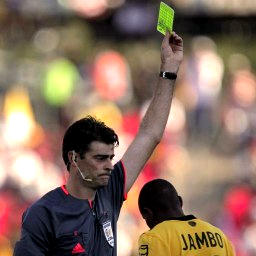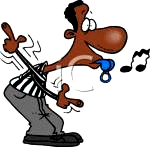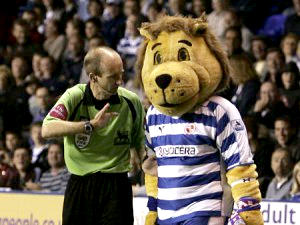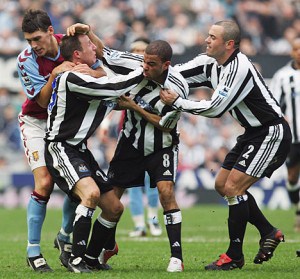| |
 |
THAT IS NOT A FOUL REF!
Foul recognition...
The science of decision-making processes among outstanding referees
WineCape's Referee Blog
IMHO – a South African Football Referee's View
 |
With the World Cup almost upon us in South Africa (kick-off 11 June
2010), I am getting numerous phone calls from people asking for football
advice and general information on the Laws of the Game. The FIFAWorld
Cup, being the biggest sporting event on the planet, and being an
occasion as much as a football extravaganza at the highest level, have
inspired some non-football watchers and friends of mine to apply and get
World Cup tickets. (They seem to have better luck getting tickets then I
do!
 ) Callers and friends are of the opinion that they are not going to miss
this historical event being held for the first time on African soil, a
lifetime experience to be enjoyed and savored, even though some are not
regular watchers of football, or soccer as its called here.
) Callers and friends are of the opinion that they are not going to miss
this historical event being held for the first time on African soil, a
lifetime experience to be enjoyed and savored, even though some are not
regular watchers of football, or soccer as its called here.
I was recently invited to a two hour radio talk on the Laws of the Game
and the most common questions asked were how many fouls are there and
when/how do you as a referee decide when it is a foul or not? The answer
to the first part is easy: ten fouls as described in Law 12, but getting
to grips on the how and when to identify fouls consistently and
correctly, given Law 12’s instructions, can take referees years to
master if they want to become top class officials.
Referee decision-making is a fascinating and complex area. Each referee
will deal with decision-making in their own individual way, and will
often rely on a combination of intuition, experience and their knowledge
of the Laws. Certain referees are capable of making instant decisions,
whilst others rely more on having the infringement played over in their
mind before calling a foul, thus giving them time to appraise all of the
relevant information and factors.
 |
Experienced referees rely greatly on their “gut feeling and
instinct,” and their own automatic conscious or unconscious
reactions when making judgment calls. Decisions based on
well-developed instincts are often proven to be correct.
Trusting your own instinct will serve you well as a referee,
more often then not. That is to say, if your instinct is well
developed! There is no substitute for experience, as instinct -
that “gut feel” – is acquired over time and practice. The
essence of outstanding referees are their ability to make
decisions instinctively within the simple framework of the 17
Laws of the Game. |
Making correct decisions are complicated by a number of
factors:
(1) a sine qua non is knowledge of the 17 Laws,
(2) the speed of play,
(3) the distance between the incident and the referee – also known as
“closeness” to play;
(4) his fitness;
(5) whether there are players obstructing the Referees' line of sight
(viewing angle);
(6) whether assistant referees are available or not;
(7) the referee’s technical aptitude or natural ability;
(8) the referee’s eyesight, including his peripheral awareness.
All the above play a role in various degrees. With regard to closeness
to play – given the saying “presence lends authority” – the following
footnote: In the 1986 World Cup, detailed referee analysis showed that
decision errors were more likely to be made when referees were too close
to the incident. When the officials got it right, they were, on average,
17 meters away from the action. The average distance in the case of
decision errors were 12 meters. Research shows the optimum distance for
correct decision making to be roughly 20 meters from incidents.
An astute referee understands that there will be many decision-making
situations that do not neatly fit the answers provided by the Laws. The
ability to interpret the Law is therefore an important asset. It is not
only an understanding of the 17 Laws that makes a good referee; it is
also his interpretation or decision-making ability, in conjunction with
common sense, self-assessment, managing the temperature of the game,
self-analysis and adhering to the overarching principles of “Spirit of
the Game” and “Fair Play.”

Research shows that in football matches referees are expected to make
many decisions (observable and unobservable) during 90 minutes. Analysis
in the Euro 2000 Final tournament suggests that an international match
official make 137 observable interventions on average
(the range is 104-162 decisions) during a game, including awarding
free-kicks, penalties, corners, throw-ins and halting play for serious
injury. 64% of these decisions were based on direct communication with
his assistants and/or 4th official. (Helsen & Bultynck, 2004).
Roughly a quarter of those decisions relate to possible interventions
pertaining to fouls and misconduct (Law 12). Each decision must be
calculated in the smallest fraction of time, usually within a second or
two. The possible responses of a referee who identified a foul vary from
(a) indirect free kick, (b) direct
free/penalty kick in combination with a yellow card (caution) or a red
card (sending off). All of these sanctions have clearly an impact on the
course of a game. Empirical observations done indicate that on average
20% of referees’ decisions are wrong when it comes to identifying fouls
and misconduct.
According to the Max Planck Research Institute, learning to make
accurate referee decisions inter alia require repeated exposure to
infringement incidents (via video training material) with corresponding
feedback. Hardly a surprise, given the old adage “practice makes
perfect.”
FIFA published a starter document in 2002 to aid match officials in foul
recognition, i.e. when fouls are being considered careless
(a free kick only), reckless (free kick +
caution) or being committed with excessive force (free
kick + expulsion).
The definitions of careless, reckless and excessive force in football
vernacular are stipulated as: A careless tackle is defined as a player
showing a lack of attention or consideration when making his/her
challenge without precaution. A reckless tackle is a player that made an
action with complete disregard for, danger to, or consequence for, his
opponent. Using excessive force means that the player has far exceeded
the necessary use of force and is in danger of injuring his opponent.
Bear in mind the definition of a foul. It’s a specified
unfair action within the ambit of offenses – as defined in Law 12 – that
is committed:
1. Against an opponent (not a team mate);
2. While the ball is in play;
3. On the field of play
All the above criteria must be present before the specific unfair action
can be classified as a foul. Further, fouls are only committed against
opponents. If a player hits his own team mate, that action is classified
as misconduct, not a foul. The restart will be an indirect free kick to
the opponents, and not a direct free kick as the case where 2 opponents
were slugging it out against one another. Does this happen in modern pro
football? Oh yes they do… It seems the English league is never short of
football examples to instruct referees. Have a look here …

Lee Bowyer vs Kieron Dyer,
fighting one another.
Newcastle (0) vs. Aston Villa (3), April 2005. |
The Football Association fined Lee Bowyer £30,000 and
imposed an additional three-game ban, and his club Newcastle
fined him a further six weeks’ wages (+/-£250,000); Dyer was not
fined as Bowyer was perceived to have thrown the first punch. In
addition, Bowyer was charged by Northumbria Police in connection
with the brawl with offences under section 4 of the Public Order
Act. He pleaded guilty to the lesser charge of using threatening
behavior, paying a further £1,600. Newcastle ended the match
with 8 players as Steven Taylor had earlier been sent off for a
second caution able offence! |
But I digress...
Indicators that referees, according to FIFA, should use to identify
specific challenges as being executed in either in a careless manner, a
reckless manner or using extreme/excessive force – sometimes referred to
as brutality – are below.
1.
Judging the body actions of the tackler by noting the point of contact –
Referees are instructed not to judge intent, but only action. The
reasoning is that we are not able to conclusively interpret player
intentions, therefore we are limited to judging their physical body
actions (flaying arms, trailing leg, raised boot with studs showing,
two- or one-footed lunges off the ground etc.);
2.
Noting the speed of the approach by the tackler on the player about to
be tackled;
3.
Looking for any signs of aggression shown by the tackler;
4.
Recognizing any signs of violence associated with the tackle;
5.
Position of the tackler: is the tackle from the back, or the side, or
from the front;
6.
What opportunity the tackler has to play the ball fairly – getting the
ball first does not necessarily imply no foul was committed if the
tackler uses speed and/or aggression disproportionately. (A seemingly
difficult concept for some pro players to accept!)
7.
Taking into account the atmosphere of the game, or the feel of the game.
FIFA has since clarified that the position of the tackler is about
fairness and player safety; that is, whether the player about to be
tackled is aware of the opponent’s location. (Do note: a tackle from any
direction which the referee judge to be careless, reckless or using
excessive force should be punished accordingly).
Being aware of match atmosphere reminds referees to be alert to the type
of match they are controlling, that is whether it is a bad tempered,
fouling affair or a skilled sporting contest. If it is a nasty contest
referees should be very alert and suspicious when a player runs hard at
an opponent. This is a good example of being pro-active in their
control, as they should be.
Julian Carosi identifies 3 types of decision-making
processes referees are faced with.
 - 1. Statutory decisions:
These are objective decisions – i.e. they are either right or they are
wrong according to the Laws of the Game.
- 1. Statutory decisions:
These are objective decisions – i.e. they are either right or they are
wrong according to the Laws of the Game.
 - 2. Interpretational decisions:
How the Referee interprets the Laws. A subjective decision, i.e. reading
between the lines
- 2. Interpretational decisions:
How the Referee interprets the Laws. A subjective decision, i.e. reading
between the lines
 - 3. Impossible decisions:
The ability to quickly and confidently make a ‘best guess’ or ‘default’
or ‘benefit-of-the-doubt’ or an ‘equal’ decision (such as a drop ball).
- 3. Impossible decisions:
The ability to quickly and confidently make a ‘best guess’ or ‘default’
or ‘benefit-of-the-doubt’ or an ‘equal’ decision (such as a drop ball).
Note that in order to correctly INTERPRET the Law, you have to KNOW the
Law. Thus (1) above is a pre-requisite for (2).
Making statutory decisions depends greatly on a Referee’s knowledge of
the Laws and his ability to keep abreast with Law changes, –
developments and – amendments during his career. Statutory decisions are
the easiest to make – because the referee knows (or should know!)
beforehand, exactly which Law is applicable for punishments or
conclusions or decisions he is basing his decision on. An example of a
common statutory Law error made by new referees, is the failure to
understand that when a free kick is taken inside the penalty area by the
defending team, the ball has to travel outside of the penalty area
before it comes into play, and before another player can touch it.
Learning the Laws by heart, and passing the initial referees’ exam is
the easy part. The difficult part is being able to apply the Laws, being
able to interpret the Laws in such a way that the players get the
maximum enjoyment out of their game. The key to this is the ability of a
referee not to be a complete dictator, but to recognize and react to the
ambiance and feel of each game, and to be able to adjust his levels of
control throughout the 90 minutes. Decision-making is key to this
requirement – along with ability to bend and flex the rules in such a
way that it promotes the Spirit of the Laws by using what is generally
known as Law 18 – Common Sense.
A few examples of where good interpretation of the Laws and quick
confident decision-making are required for a referee to retain his
credibility as an official: (a) Was the handball deliberate? (b) Should
the player be cautioned or will a stern public warning suffice? (c) Can
a referee drop the ball to the goalkeeper without any other players
being involved? (d) Is the attacking player standing in an offside
position, actively involved with play or not? Common sense and Law
interpretation used fairly and correctly, separates the good referees
from the not-so-good officials.
The third part of the decision-making process is the impossible
decisions. There will be many occasions in each game, when it will be
impossible for the referee to make a correct decision: (a) Has the ball
crossed the goal line marginally with the referee (or his assistant)
many yards away and not 100% sure? (b) Two opponents are competing for
possession of the ball very near to the goal line. The ball
simultaneously hits the shins of both players, and travels completely
over the goal line. Both teams are equally entitled to the decision. But
what should the referee award – a goal kick or a corner kick?
The decisions mentioned in the above examples seem to be the most
difficult ones to make, but with a little preparation they are,
according to Julian Carosi, the easiest decisions to make if you take
note of the following criteria:
 - Be ready by anticipating problems
- Be ready by anticipating problems
 - Get as near as you can to active play
- Get as near as you can to active play
 - Be firm
- Be firm
 - Be quick
- Be quick
 - Be positive
- Be positive
 - Do not waver or hesitate
- Do not waver or hesitate
 - Stand erect when delivering your decision
- Stand erect when delivering your decision
 - The more difficult the decision – the more you will need to “sell” it
- The more difficult the decision – the more you will need to “sell” it
 - Look players in the eye confidently
- Look players in the eye confidently
 - Provide clear and quickly delivered signals
- Provide clear and quickly delivered signals
 - Do not be influenced by others once you have decided what to do
- Do not be influenced by others once you have decided what to do
 - Your decision counts and nobody else’s. So be ready to deal with the
inevitable ensuing dissent
- Your decision counts and nobody else’s. So be ready to deal with the
inevitable ensuing dissent
 - Look at the reaction and the body-language of the players, i.e. don’t
(out of hand) dismiss passionate shouts by a team for a decision in
their favor
- Look at the reaction and the body-language of the players, i.e. don’t
(out of hand) dismiss passionate shouts by a team for a decision in
their favor
 - Don’t worry too much if everybody else thinks you are wrong – for now,
you’re right!
- Don’t worry too much if everybody else thinks you are wrong – for now,
you’re right!
 - And finally – maintain 100% concentration at all times.
- And finally – maintain 100% concentration at all times.
Note: In situations where the referee has realized he
made a genuine mistake, he can change his decision, according to the
Laws of the Games, as long as play has not restarted or he has not blown
for the end of the match. Players and coaches are usually receptive to
an honest mistake being rectified – the referee just needs to admit that
he was wrong in the first place.
Embed default decision-making scenarios in your mind. Some standard
examples of these types of decisions are shown below. If you can adopt
these, it will make your impossible decision-making very easy and
automatic. The trick is to make life as easy as possible for yourself by
lessening any potential trouble ensuing because of your decision.
If you need to make a decision but are not sure which way to
go:
 - Award throw-ins to the defending team.
- Award throw-ins to the defending team.
 - Award a goal kick rather than a corner kick.
- Award a goal kick rather than a corner kick.
 - If you are unsure whether an attacking player is offside or not – give
the benefit of doubt to the attacking team.
- If you are unsure whether an attacking player is offside or not – give
the benefit of doubt to the attacking team.
 - If you are unsure of whether the ball was last played by defender or
an attacking player when deciding offside, give the benefit of doubt to
the attacking team.
- If you are unsure of whether the ball was last played by defender or
an attacking player when deciding offside, give the benefit of doubt to
the attacking team.
 - Award free kicks to the defending team – especially during corner
kicks.
- Award free kicks to the defending team – especially during corner
kicks.
 - Is it a direct free kick just outside the penalty area or is it a
penalty kick? Award a direct free kick.
- Is it a direct free kick just outside the penalty area or is it a
penalty kick? Award a direct free kick.
 - Is it a penalty or not? No penalty.
- Is it a penalty or not? No penalty.
 - So called “Orange card” tackles – the foul is a caution/yellow (i.e.
reckless challenge), but it borders on red (i.e. serious foul play).
What to do? Sent off! Err on the side of an expulsion, as per Fifa’s
latest mantra. Coaches will rather accept a “harsh” red then a “weak”
yellow.
- So called “Orange card” tackles – the foul is a caution/yellow (i.e.
reckless challenge), but it borders on red (i.e. serious foul play).
What to do? Sent off! Err on the side of an expulsion, as per Fifa’s
latest mantra. Coaches will rather accept a “harsh” red then a “weak”
yellow.
 - Was the handball deliberate or not? Not deliberate. (See criteria
below)
- Was the handball deliberate or not? Not deliberate. (See criteria
below)
 - Has a goal been definitely scored or not? No goal.
- Has a goal been definitely scored or not? No goal.
FIFA also defines the criteria to help referees assess the
deliberateness of handball. Handball is defined as the whole arm,
stretching from the outer shoulder to the fingertips. Handball is not an
offense. It has to be deliberate. Factors that could help in classifying
handball as deliberate and thus an offense punishable with a direct free
kick are:
 - Distance of the kicker and the player;
- Distance of the kicker and the player;
 - The reaction time the player has, if any, to move his arm away
(unexpected ball);
- The reaction time the player has, if any, to move his arm away
(unexpected ball);
 - Original hand/arm position of the player;
- Original hand/arm position of the player;
 - Whether the ball moved towards the hand/arm (ball kicked onto the arm)
versus a hand/arm moving towards the ball.
- Whether the ball moved towards the hand/arm (ball kicked onto the arm)
versus a hand/arm moving towards the ball.
If the above factors do not convince the referee to punish the
infringement, he is instructed to refrain from calling handball.
“Deliberate” means that the player could have avoided the touch with his
arm/hand but chose not to. Moving your hands or arms instinctively to
protect the body when suddenly faced with a fast, unexpected approaching
ball does not constitute deliberate contact unless there is subsequent
action to direct the ball once contact is made. Likewise, placing the
hands or arms to protect the body at a free kick or similar restart is
not likely to produce an infringement unless there is subsequent action
to direct or control the ball. The fact that a player may benefit from
the ball contacting his hand does not transform the otherwise accidental
event into an infringement.
“That is NOT a foul ref!” or “Are
you booking me for that?” My usual retort on-field is to
ask said player what Law has been transgressed or not, if he’s then so
certain of his case? Silence is mostly the reply. If you want to
interpret the Law correctly, you have to know the Law first.
Paradoxically, given that they ply their trade in professional football,
most professional players, coaches and football commentators – it seems
ex-pro players going into journalistic careers are not exempt either -
in South Africa are clueless when it comes to the first basic step; real
knowledge of the 17 Laws of the Game, never mind interpreting the Laws
correctly according to FIFA directives.
| The hardest aspect of being a English Premier League
Referee? 62% of the Referees revealed that they generally
thought the uneducated, personal, biased and unfair scrutiny
they were subjected to by the media was a burden on their
officiating role in the Premier League. – Mason &
Lovell 2000 |
A SAFA Referee course was held some years ago for football commentators.
Most did not bother to pitch up. Yet, they are the so-called pundits
where millions believe every word or opinion on the Laws they utter on
live television and print. That’s not to say commentators are always
incorrect and Referees don’t make any mistakes; I’m willing to bet my
FIFA toss coin that referees will have 50% less “trouble” if these
football “pundits” really know the Laws and interpretations as
they should be applied according to FIFA, as per the
well-informed SABC television commentator Duane Dell’Orca (and a very
small minority) that has shown consistently and admirably their
knowledge on the Laws of the Game over the past few seasons.
I have lost count the amount of silly yellow cards I issued to players
this season because they refuse to respect the 10-yard distance at free
kicks in the professional league. In this regard the Law allow referees
not much leeway or discretion. If a player refuses to move back -
usually after I warn them first – they must be cautioned. Tell that to
players, coaches and commentators complaining that referees should use
their discretion in this instance. There is no interpretation, no
discretion, no discussion. It’s
black … or white.
|